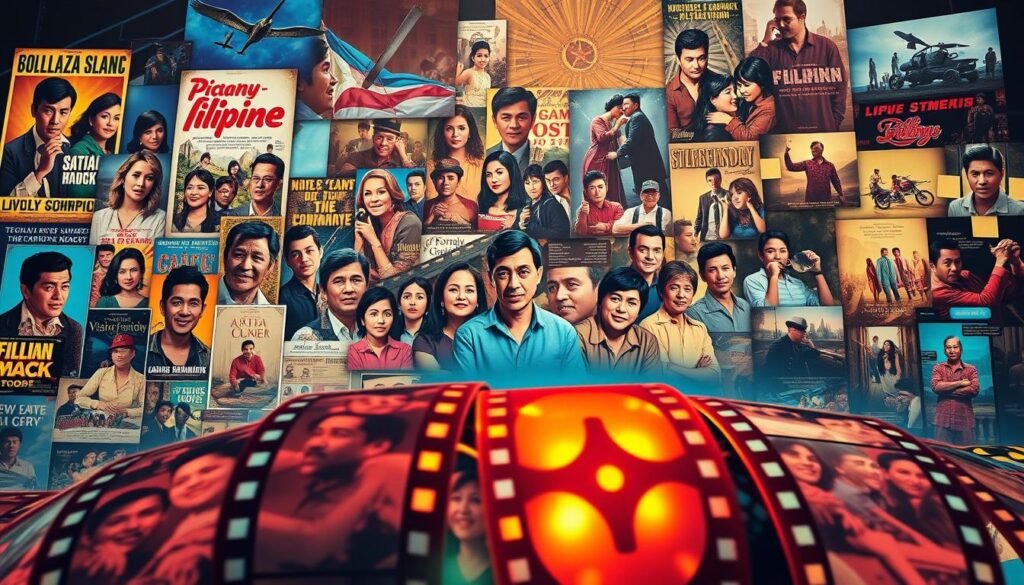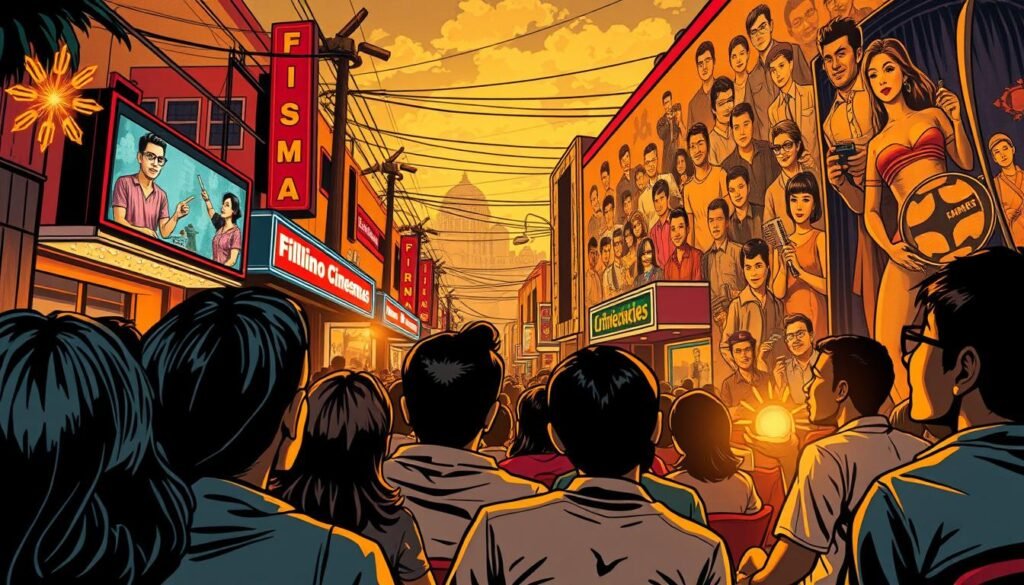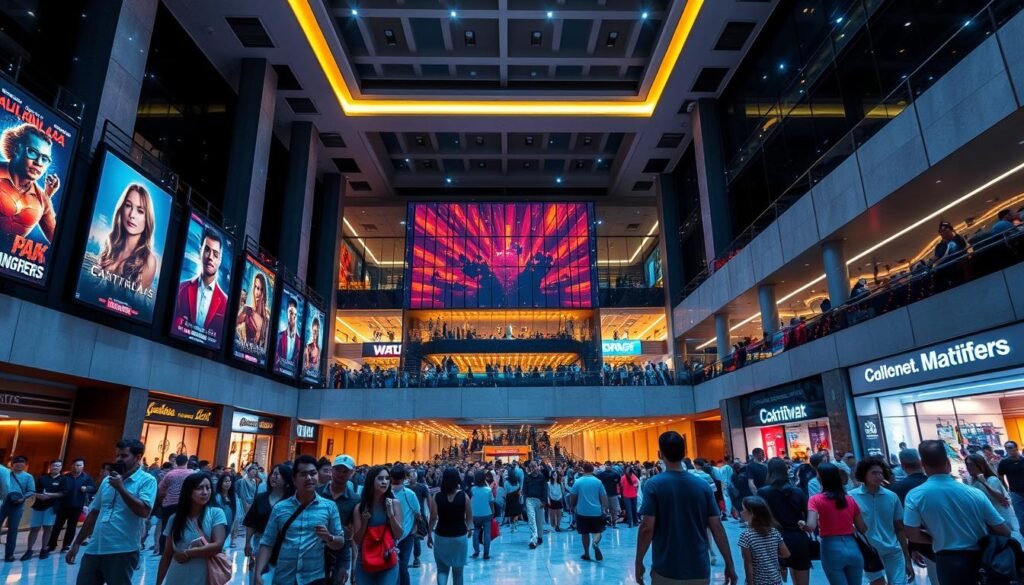The post-war period marked a transformative phase for Filipino cinema, emerging as a powerful cultural force. Defined as both an art form and an industry, cinema became a medium for storytelling and economic growth. This era saw the blending of global influences with local narratives, creating a unique cinematic identity.
Technological advancements and economic shifts played a crucial role in shaping the industry. New techniques and storytelling methods emerged, reflecting the resilience and creativity of Filipino filmmakers. These changes not only enhanced the quality of films but also mirrored trends seen across the world.
Filipino cinema during this time became a mirror of society, capturing the struggles and triumphs of the nation. It played a vital role in shaping cultural expression and national identity. The industry’s growth was a testament to the enduring spirit of the Filipino people, setting the stage for future innovations.
Key Takeaways
- Filipino cinema became a cultural force in the post-war era.
- Global influences blended with local narratives to create unique stories.
- Technological advancements improved film quality and techniques.
- Cinema reflected societal changes and shaped national identity.
- The industry mirrored global trends while maintaining its distinct voice.
The Evolution of Filipino Cinema Post-War
After World War II, Filipino cinema began to evolve, drawing inspiration from both international and domestic influences. This period marked a significant shift, as filmmakers blended global techniques with local stories. The result was a unique cinematic identity that resonated with audiences worldwide.

Influences from Global Film Trends
The post-war era saw the rise of new storytelling techniques and cinematic technologies across the world. Filipino filmmakers adopted these innovations, enhancing the quality of their productions. For example, the introduction of synchronized sound and color film transformed the industry.
International film movements, such as Italian Neorealism and French New Wave, also left their mark. These styles inspired Filipino directors to experiment with narrative structures and visual aesthetics. This cross-cultural exchange enriched the local industry, making it a vital part of global entertainment.
Local Innovations and Historical Milestones
While global trends played a role, Filipino cinema also developed its own unique voice. Local filmmakers introduced groundbreaking techniques, such as the use of natural lighting and on-location shooting. These innovations added authenticity to their stories.
Historical milestones further shaped the industry. For instance, the 1950s saw the Philippines become one of Asia’s leading film producers. By the 1970s, however, the dominance of Hollywood films posed challenges. Despite this, the industry adapted, producing films that reflected the nation’s struggles and triumphs.
| Decade | Key Milestone |
|---|---|
| 1950s | Over 350 films produced annually, second only to Japan in Asia. |
| 1970s | Local releases dropped to 50 films per year due to Hollywood’s dominance. |
| 1980s | Despite challenges, 200 films were produced annually, showcasing resilience. |
Filipino cinema’s ability to adapt and innovate reflects its enduring spirit. From colonial influences to modern-day challenges, the industry continues to thrive. To learn more about the historical context, visit this resource.
Understanding Cinema: Its Impact on Culture and Entertainment
In the aftermath of World War II, Filipino society experienced profound cultural shifts, with cinema playing a pivotal role. As the nation rebuilt, movies became a mirror of societal changes, reflecting the struggles and aspirations of the people. This era marked the beginning of cinema’s transformation into a powerful cultural force.

Cultural Shifts in Post-War Filipino Society
Filipino cinema became a catalyst for cultural transformation during the post-war era. Movies not only entertained but also educated, shaping public opinion and fostering a sense of national identity. Themes of resilience, hope, and rebuilding dominated the narratives, resonating deeply with audiences.
Global cinematic trends also influenced local filmmaking. Techniques from Italian Neorealism and French New Wave inspired Filipino directors to experiment with storytelling. This blend of global and local styles created a unique cinematic voice that captured the spirit of the times.
Movies evolved to reflect societal moods and values. For instance, films from the 1950s often highlighted the struggles of rural life, while those from the 1970s addressed urban challenges. This adaptability showcased cinema’s ability to remain relevant and impactful.
| Decade | Key Themes |
|---|---|
| 1950s | Rural struggles, family values, and resilience. |
| 1970s | Urbanization, social inequality, and political unrest. |
| 1980s | Economic challenges, migration, and cultural identity. |
Cinema’s role in educating and entertaining a society in transition cannot be overstated. It provided a platform for discussing pressing issues, from poverty to discrimination, while offering an escape from daily hardships. This dual purpose solidified its place as a cornerstone of Filipino culture.
Today, the legacy of post-war cinema continues to influence modern filmmaking. Its ability to blend global trends with local narratives remains a testament to the enduring power of storytelling. As the world of entertainment evolves, Filipino cinema stands as a reminder of its profound cultural impact.
Exploring Filipino Movie Experiences in Modern Venues
Modern Filipino movie experiences have transformed with the rise of malls and entertainment complexes. These venues now serve as central hubs for film viewing, blending convenience with advanced technology. This shift has reshaped how audiences enjoy movies, making it a seamless part of urban life.

Malls as Entertainment Destinations
Malls across the Philippines have integrated cinemas into their design, offering a one-stop destination for shopping, dining, and entertainment. This trend caters to the fast-paced lifestyle of urban Filipinos. For example, SM Supermalls operates 384 screens nationwide, making it a leader in this space.
These mall-based cinemas feature state-of-the-art technology, such as digital projection and surround sound. Comfortable seating and spacious theaters enhance the viewing experience. This focus on quality has attracted audiences, even as the industry recovers from pandemic setbacks.
Innovations in Movie-Going
Modern venues are not just about watching films; they offer a complete entertainment package. Many cinemas in Manila, like Ayala Malls Cinemas, include food courts and leisure spaces. This integration allows families and friends to socialize before or after a movie.
- Advanced digital technology improves picture and sound quality.
- Comfortable amenities, such as reclining seats, enhance the experience.
- Food and retail options create a holistic entertainment environment.
These innovations reflect global trends while adapting to local preferences. For instance, the resurgence of Filipino cinema highlights the industry’s ability to evolve and attract audiences.
Examples from Manila
Manila’s entertainment complexes showcase the best of this trend. SM Mall of Asia and Ayala Malls’ Trinoma are popular destinations for movie-goers. These venues combine modern cinemas with diverse dining and shopping options.
Events like the CCP National Theater Live Season 2 further enrich the experience, offering world-class productions in accessible locations. This blend of local and global content keeps audiences engaged.
As the Art Fair Philippines demonstrates, these venues are also cultural hubs. They host film festivals, art exhibits, and community events, making them vital to urban life.
This evolution of movie experiences in malls reflects the Philippines’ dynamic entertainment culture. By merging retail, socializing, and film, these venues have become essential to modern Filipino life.
Conclusion
Filipino cinema has journeyed from its post-war roots to become a cornerstone of cultural expression, blending global trends with local creativity. The industry’s evolution reflects a unique narrative shaped by both international influences and homegrown innovations. From the 1950s to today, it has mirrored societal changes, fostering a sense of national identity.
The world of filmmaking has always inspired Filipino directors, yet they’ve carved out a distinct voice. Techniques like natural lighting and on-location shooting added authenticity to stories, while themes of resilience and hope resonated deeply with audiences. This adaptability has kept the industry relevant across decades.
Today, Filipino cinema continues to bridge historical contexts with modern entertainment experiences. Its ability to reflect the world’s trends while staying true to local narratives ensures its enduring influence. As the industry evolves, it remains a vital part of the global film landscape. To explore more about its rich history, visit this resource.
FAQ
How did global film trends influence Filipino cinema after World War II?
Post-war Filipino cinema was shaped by international styles, such as Hollywood’s storytelling techniques and European realism. These influences helped local filmmakers experiment with new genres and storytelling methods.
What were some key milestones in Filipino cinema during the post-war era?
The post-war period saw the rise of iconic directors like Lamberto Avellana and the emergence of socially relevant films. This era also marked the growth of independent filmmaking and the establishment of major studios.
How did cinema impact Filipino culture after the war?
Films became a mirror of society, reflecting the struggles and aspirations of Filipinos. They played a vital role in shaping national identity and addressing social issues during a time of rebuilding.
Why are modern movie theaters often located in malls?
Integrating theaters into malls creates a one-stop destination for shopping, dining, and entertainment. This setup enhances the overall experience, making it convenient for audiences to enjoy films alongside other activities.
What makes the movie-going experience unique in modern venues?
Modern venues offer advanced technology like IMAX and 4DX, comfortable seating, and diverse food options. These features elevate the experience, making it more immersive and enjoyable for viewers.
Source Links
- History of Philippine Cinema – National Commission for Culture and the Arts
- Cinema of the Philippines
- History of Philippine Cinema – San Diego Filipino Cinema
- Creating Ripples in Philippine Cinema: The Rise of Regional Cinema
- These 6 Filipino Films Merge Cinema and Social Commentary
- Entertainment and Pop Culture: A Dynamic Landscape
- The Impact of Cinema on Society: Inspiring Change and Shaping Culture
- Welcoming audiences back to movie theaters – BusinessWorld Online
- Drive-In Cinemas: The Philippines’ New Movie Escapism Route
- Independent Cinemas in the Philippines | Crown Asia
- Conclusion: The Technology of Science Fiction Cinema (Chapter 8) – Science Fiction Cinema
- Beginning film studies (second edition)

